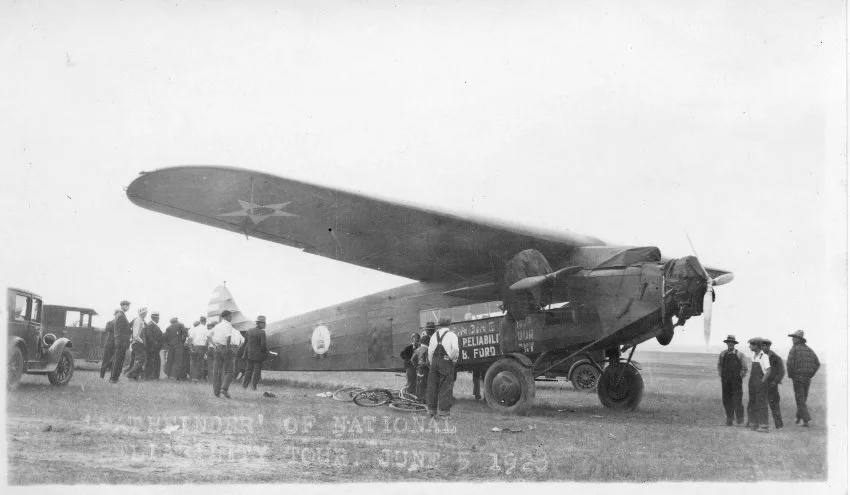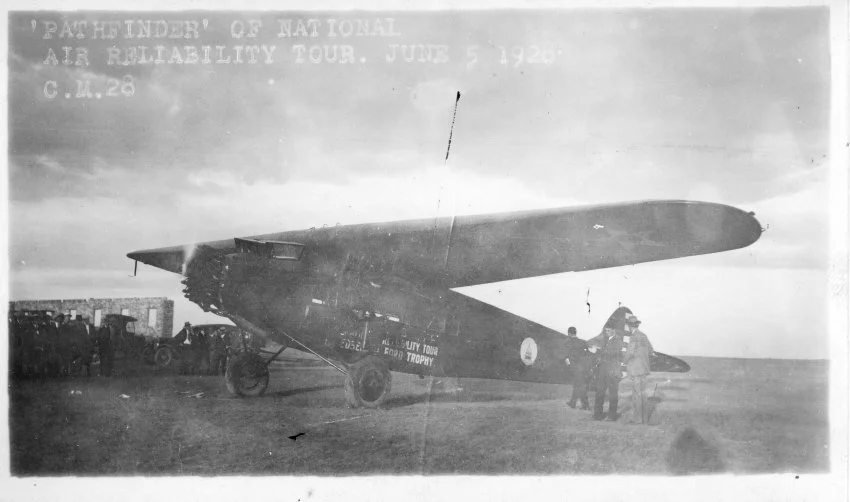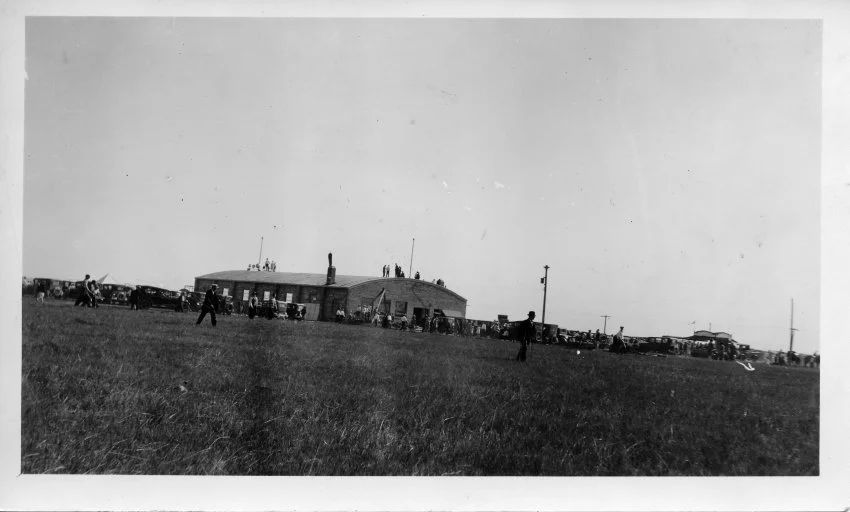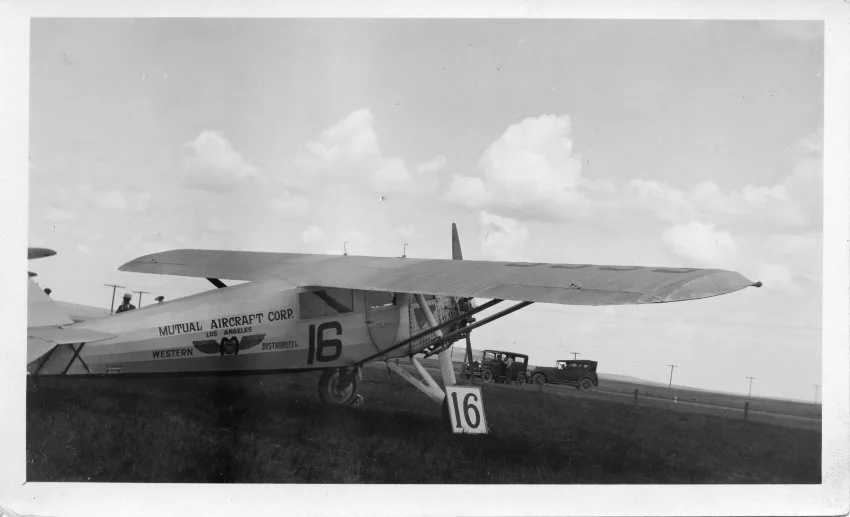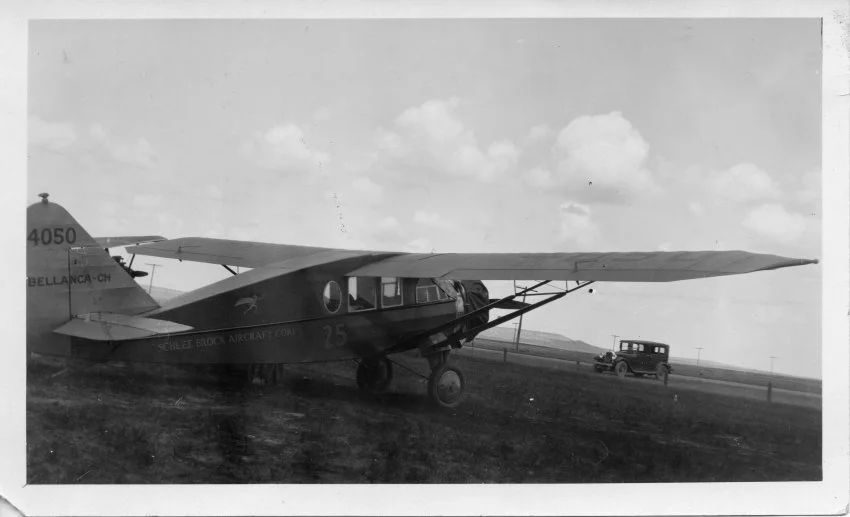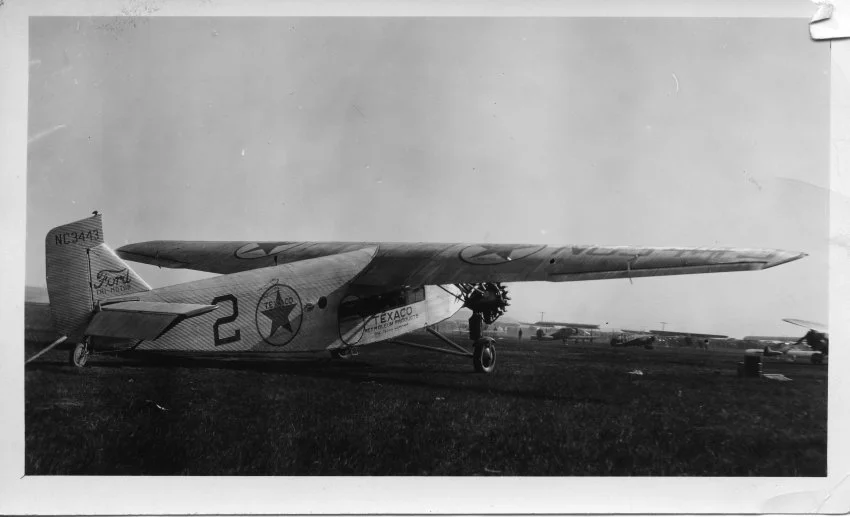The National Air Tour Reaches Great Falls, 1928
Known as the National Air Tours or Ford National Reliability Air Tours, the “The National Air Tours for the Edsel B. Ford Reliability Trophy” were competitive flying tours that occurred 1925-1931. The purpose of the tours was to promote and develop the commercial aviation industry as a safe and reliable mode of transportation. At the time, many Americans were still skeptical of aviation, which seemed to be best suited for soldiers or the occasional daring pilot.
Pilots in the tours would compete in the air and on the ground to demonstrate steady speed and precise landing. Competing pilots would face elimination as the competition travelled across the country.
The First Annual Aerial Reliability Tour launched in 1925, crossing 1,900 miles with stops in 10 cities. The 1928 tour grew to include 35 stops on a 6,300-mile circuit that almost circumnavigated the continental United States, reaching the western coastlines of California, Oregon, and Washington. The tour began in Dearborn, Michigan at the Ford Airport and travelled in a clockwise path across the country, stretching as far south as San Antonio, Texas.
Great Falls Tribune clipping showing the National Air Tour route, July 7, 1928
Earl T. Vance, manager of Vance Air Service, and operator Edward L. Shields had applied for Great Falls to be included on the tour during the All-American Aircraft show in Detroit, Michigan. Vance had pledged to raise $1,000 to secure Great Falls on the Air Tour route, which would place the river city firmly on the air maps of the United States.
“Trans-Atlantic Fliers will be in Falls with National Air Tour Party July 21-22” Great Falls Tribune clipping, July 11, 1928
On June 4, 1928, Ray Cooper, tour manager, was scheduled to pilot a large army Fokker airplane pathfinder ship to scout the Great Falls location. This was the first three motored plane ever to land in Great Falls. Three recently completed runways at Vance Air Service, each nearly a mile long, were the only runways capable of landing the sizable plane. In preparation of the visit, crews cleared the field of all rocks, removing 150 loads of stone. Vance’s aircraft hangar, capable of housing eight large planes and a repair shop on the field, was quickly under construction, scheduled for completion at the end of June. The Vance airplanes were prepared to escort the scouting Fokker to the flying field, spruced up with fresh coats of paint, black bodies and orange wings. They would also be ready for public tours, offered the day of the scouting plane’s arrival.
Payment of $1,000 was due when Cooper and his party arrived to secure Great Falls’ place on the National Air Tour. Canvassing the city for contributions, it only took Earl Vance and Ed Shields 19 hours on July 2 to raise the promised funds, raising even additional dollars towards the event.
“Pathfinder” of National Air Reliability Tour, June 5, 1928. Great Falls Public Library Collection, Moe Album [1993.111.0027-51]
At the approaching arrival time of Cooper on June 4, Vance took to his plane to circle the city and blow his siren, signaling the public to head to the air service to watch the arrival.
“A considerable number of cars had arrived when the big ship, graceful and beautiful, sailed across the heavens from the southwest.” -Great Falls Tribune, June 5, 1928
The Great Falls Tribune estimated at least 2,000 visitors had arrived in the first hour of the aircraft’s arrival.
“Pathfinder” of National Air Reliability Tour, June 5, 1928. Great Falls Public Library Collection, Moe Album [1993.111.0027-39]
Cooper and Ray Collins, tour referee, praised the new Vance field and said it was one of the best they had landed on. Lieut. Peter E. Skause, meeting the party at Vance field, remarked that he had not expected to find such a field in Great Falls, commenting also on the “big stack” of the Anaconda Copper Smelter and its use as a landmark and wind indicator.
Cooper’s party was invited to Strain’s tea room for a luncheon and stayed in Great Falls overnight.
The party departed the following morning at 5am for Minot, North Dakota, stopping at Froid, Montana at the invitation of Senator J. W. Schnitzler, “the flying Montana senator.”
A view of the Air Tour from the roof of the Vance hangar by Great Falls Photo View Co., Great Falls Tribune clipping, July 22, 1928
The event was set. Sheriff Bob Gordon, Chief of Police R. S. Gaunt, and Earl T. Vance prepared the public July 14 by advising caution that spectators should stay in their cars as planes landed and to stay behind the recently installed low fencing to prevent injury from landing planes and their propellers.
“The occasion has attracted sufficient attention over the state to cause the Great Northern and Milwaukee railroads to both grant reduced rates to Great Falls July 21 and 22. The Great Northern’s rate of a fare and a third was announced several days ago and Thursday local Milwaukee officials were authorized to announce that a similar fare would be granted by that road.” -Great Falls Tribune, Friday, July 13, 1928
Vance Air Field aircraft hangar with large crowd, Great Falls Public Library Collection, Moe Album [1993.111.0027-54]
On Saturday morning, July 21, they arrived. The National Air Tour contestant planes, headed by an army Douglass 0-2, carrying Capt. Ray Collins, Capt., R. G. Greene, came into view. In close follow was the trimotor army transport Fokker, known as the “flying press room” containing newspaper representatives. The first plane to land was contestant D. P. Levy’s Stearman plane at 10:36am.
The Great Falls Leader reported Saturday evening that thousands of Great Falls residents came to watch the ships land at Vance Field. Spectators in cars lined the short fences with officers standing by to keep any anxious members of the public off the landing strip.
Mutual Aircraft Co. Ryan B-1 Broughham NC5553, plane #16 piloted by Vance Breese. Great Falls Public Library Collection, Moe Album [1993.111.0027-42]
“The trim looking, well flown ships, their painted bodies and wings representing every color in the rainbow, dropped until their wheels lightly touched the ground, the crowed gasped in admiration.” -Great Falls Leader, July 21, 1928
Pilots and their passengers were met by local hosts, appointed by the local chapter of the National Aeronautic Association, and taken to the Rainbow Hotel.
“Already an air minded city the numerous planes here today will place it further along the road towards becoming on of the ‘aviation’ cities of the county.
“As a small boy asked his father at the field, ‘why don’t you get one, Pop?’ His ‘Pop’ replied, ‘Well, mebby I’ll have to now. They sure seem to travel alright.’” -Great Falls Leader, July 21, 1928
Schlee Brock Aircraft Co. plane, #25, piloted by George W. Haldeman. Great Falls Public Library Collection, Moe Album [1993.111.0027-48]
Event sponsor Texas Pacific Coal and Oil Company gave a formal dinner at the Rainbow Hotel’s Palm Room.
The Anaconda Copper Mining Company hosted an informal party of visitors, and the Anaconda Copper Mining Company Orchestra performed during dinner, followed by with “Hawaiian Singers,” who appeared at the Grand Theater earlier that evening.
The Great Falls Leader estimated about 200 guests for the evening.
“The guests at the dance also included a number of popular Great Falls girls and women.” -Great Falls Tribune, July 22, 1928
Texaco Ford Trimotor piloted by Frank Hawks, airplane #2. Great Falls Public Library Collection, Moe Album [1993.111.0027-45]
When it was time on Sunday morning for the Air Tour to continue back towards Detroit, a large crowd of spectators gathered to watch as the remaining 22 pilot contestants took off from Vance Field.
“A flock of man made birds, winged for flight over land and sea, rose from the Vance field here Sunday morning and proceeded east. One by one 24 ships of the National Air tour took off and headed northeast to Froid […]” -Great Falls Tribune, Monday, July 23, 1928
Within a minute interval of each other the planes took off, one racing down the runway just as soon as the plane ahead lifted off.
Great Falls residents had seen the biggest variety of aircraft to visit the state yet.
Commemorative copper ashtray produced by the Anaconda Copper Mining Co. (ACM) for the 1928 National Air Tour’s July 21, 1928 visit to Great Falls. ACM logo stamped on the backside. [1984.141.5]
Ad placed by multiple Great Falls businesses in the Great Falls Leader, July 21, 1928
-Ashleigh McCann, Collections Curator
Special thank you to the Davis-Monthan Aviation Field Register and the Delta Mike Airfield, Inc. for their website and information on the Ford Reliability Tours which was critical for identifying the airplane photographs in our collection and adding additional context. More information on the 1928 tour can be found here, including scans from a booklet and photo album for Great Falls.



